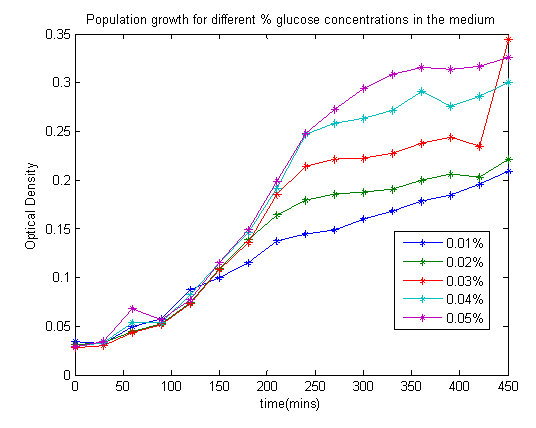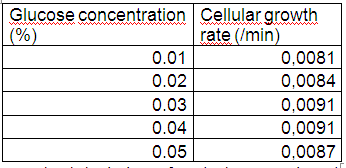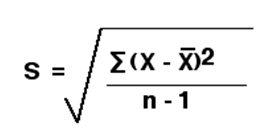Team:Imperial College London/Wetlab/Results/Autoinduction/Gluonly
From 2009.igem.org

Experiment:
In a 96-well plate, initial concentrations of glucose ranging from 0.01% to 0.05% of the culture were studied. There are several possible effects that it could exert on cell growth and the hypotheses are stated below:
1.The lower the initial amount of glucose in the medium, the shorter the time taken for the population to reach saturation level.
2.The lower the initial amount of glucose in the medium, the lower the growth rate prior saturation level, but no delays on the time taken to reach saturation.
In addition, we also know that a lower amount of glucose means that the population will grow less and saturate at a smaller value.

Figure 1: Glucose growth curves
We can see that initially, there is an exponential growth phase followed by saturation of growth once glucose has been used up. In this diagram, effects of different glucose concentrations on growth rate are not apparent. Instead, a more informative measure is the growth rate during the exponential growth phase. As we know, if the OD curves follow exponential expression in the form of:
y=yoexp(rt)
where r is the growth rate, t is the time in hours, y is the absorbance/OD over time and yo is the initial absorbance/OD, we can simplify the relationship such that:
log(y)=log(y_o+ rt)
So when we plot log y against t, there is a linear relationship in the exponential growth phase, so we can estimate the growth rate r from there.

Figure 2: Log data of optical density showed for exponential region for the first 150minutes of growth.
Visual assessment of these plots shows that between time=0-150 mins, there is a linear phase, so we fit a straight line (red) to estimate the growth rate. After 150 mins, the growth starts to saturate and the exponential relationship no longer applies, so the points were discarded.
The estimates of the growth rates shown in the table below show if different glucose concentrations affect cellular growth rate in the exponential phase:

Table 1: Estimated growth rate for the first 150 minutes for different % glucose concentrations.
Standard deviation of each dataset, given by:

Where n= 6 (points used to fit line) and x ̅ is the mean of the sample.
Average rate = 0.0087
Standard deviation = 4.39e-4
Standard error of the mean = 8.78e-5
Discussion and conclusion
We can see that for this range of values, the standard deviation is very small. This means that in the exponential phase, growth rate of the culture does not vary significantly. Furthermore, different initial concentrations of glucose do not have an effect on the time taken for the population to saturate so there are no delays in the encapsulation process for different glucose concentrations.
This means that both hypotheses are ruled out: Regardless of initial concentrations of glucose present in the medium, bacterial growth starts off at the same initial rate. Depending on the amount of resources present, the bacteria will compensate by entering a “low consumption mode” and saturating the population at a lower level. However, no matter what the initial concentration of glucose, this always happens at the same time.
Therefore, we conclude that different initial concentrations of glucose in the medium do not affect the start of the encapsulation process.
 "
"



